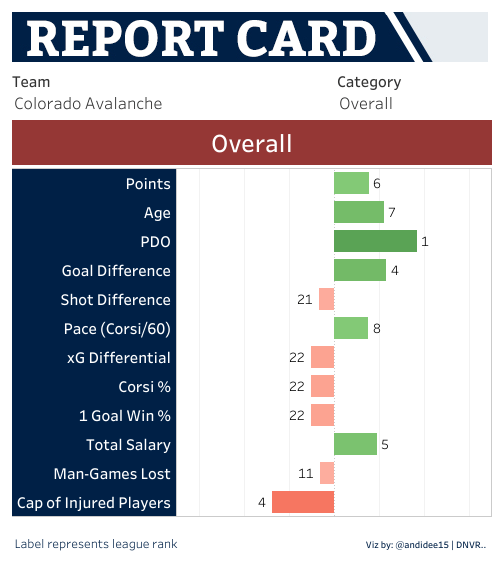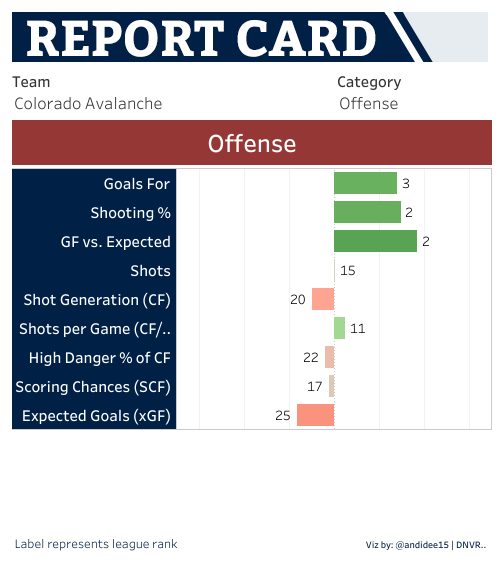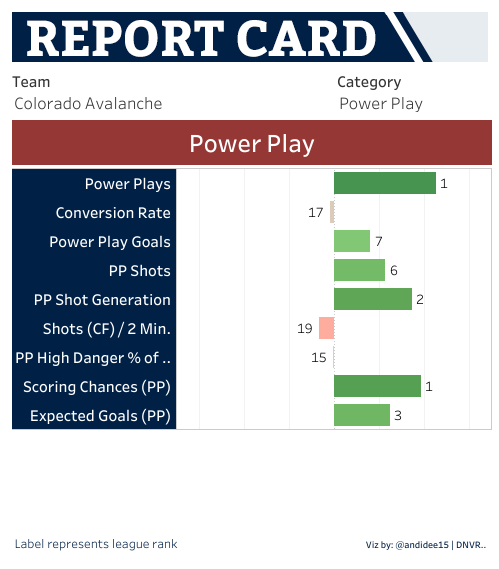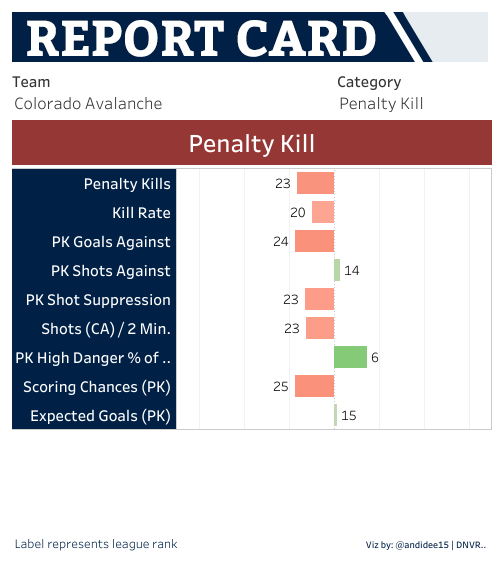© 2025 ALLCITY Network Inc.
All rights reserved.

Last Tuesday, the Avs played their 21st contest of the 2019-2020 season, officially hitting the quarter mark of the campaign.
While it might feel like the season just started, the twenty game mark is a bit of a special number. Unlike earlier in the season when good games and bad games can drastically impact overall stats, everything starts to smooth out around this time. It’s our first chance to get a read on how teams are really doing, and more importantly, on how they’re likely to do for the rest of the year.
The Big Picture
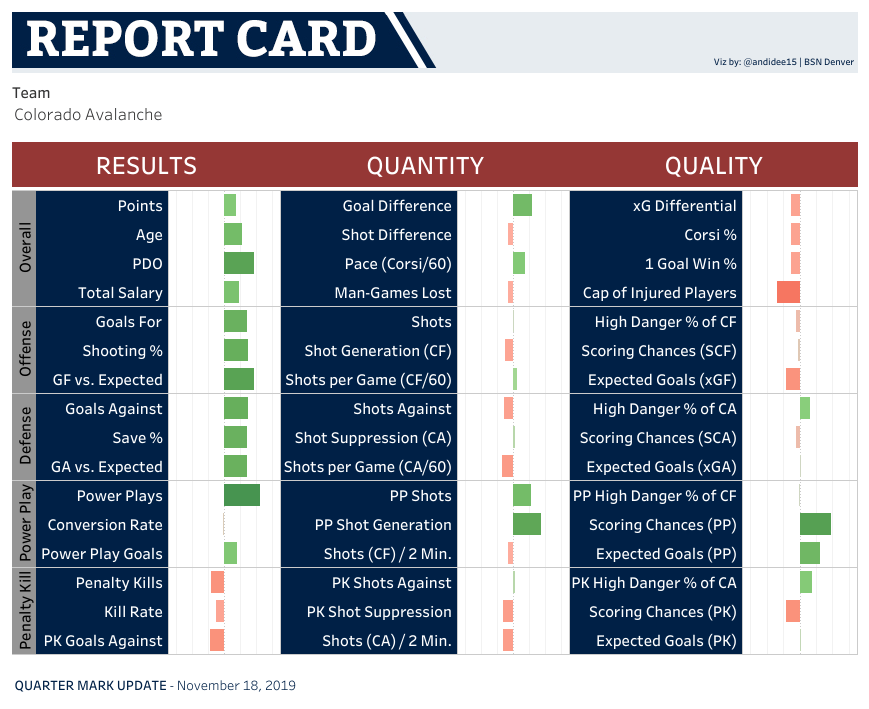
There’s a lot to unpack in this report card, but the biggest thing to remember is that green is good/lucky while red is bad/unlucky.
At a quick glance, the Avs’ results have been outstanding (penalty kill excluded), but their quantity and quality don’t really support it. They’ve been playing like an average team and winning games like an elite one.
That’s not necessarily a bad thing – in this 31-team league, the truly average teams ranking 15th and 16th typically make the playoffs as wildcards. Even if the Avs changed nothing, they still probably make the postseason.
Unfortunately, expectations have ratcheted up. Everyone knows they’re a better team than that. Now it’s up to them to prove it.
So how do they take their game to that next level through the remaining 61 games of the season?
Let’s break it down by category.
Overall
The first area where the Avs need to improve is something they have absolutely no control over: health, particularly that of their star players.
According to NHL Injury Viz, Mikko Rantanen has missed 14 games due to injury. Captain Gabe Landeskog has missed 12. Starting goalie Philip Grubauer has missed five, and his backup, Pavel Francouz, missed two concurrently. That’s not to mention the seven other players who have suffered everything from lower-body injuries to concussions to broken jaws.
Interestingly, the Avs are right around league average with their 48 man-games lost to injury at the 20 game mark. Unfortunately, they rank fourth in the league when you factor in cap hit to measure how important a player is to his team. Based on the Rantanen injury, in particular, the Avs have rocketed out to fourth most injured in the league by that stat.
That’s a critical note to start this analysis on since we don’t really know who the Avs are when healthy. Everything else you’re about to read may prove null and void once more talent starts returning to the roster.
That’s great news given another stat found in this category. PDO measures a team’s shooting percentage and save percentage at even strength, and when it’s far off 100%, you know change is coming. For the Avs, they’re currently sitting at 103.3%, which is a very high number in terms of this stat.
Call it luck, call it fortunate bounces, call it what you will, but hockey is a sport of hot and cold streaks. The Avs have been on a hot one to start the year, especially considering the number of starters who are out and the less talented call-ups they’ve had skating in their place.
This streak will end; it’s just a question of when. With any luck, it coincides with the return of their roster regulars. The best way to offset a PDO slide is to generate higher quality offense and play better defense, and getting the top line in particular back together would be a huge boost in both areas.
Offense
As mentioned earlier, the Avs are getting tremendous results with an average process. They’re dead on league average in the number of shots they fire on target and a little below in the number of shots they attempt.
Their quality is fairly average too. The percent of their shot attempts coming from the goalies’ doorstep isn’t anything to write home about, nor are their number of scoring chances including those on the rush. And their expected goals totals – factoring in both quality and quantity – are near the bottom of the league.
This may seem a bit doom and gloomy, but there are some reasons for hope. First of all, the Avs play less 5v5 than any other team in the league. They’re first in power play opportunities, eighth in the number of penalties they take, and average 15 minutes of special teams a night. On the other side of the spectrum, the Islanders average a little under 10.
Over the course of 20 games, those extra five minutes a night add up when looking at raw counts. If you take even strength time on ice into account like the shots per game (CF/60) stat does above, you can see that the Avs are still mediocre but switch to above league average instead of below. It doesn’t sway the numbers a ton, but it does rosy them up a bit.
The other reason for hope is this team is average despite the massive injuries the forward corps has sustained. There’s reason to believe things will improve as the regulars come back even without any major system-wide changes.
However, if the Avs are looking for an area to improve even with the personnel they currently have, the best place to do so would be encouraging the defense to continue to work the puck down low instead of taking low danger shots from the point. They usually do a pretty good job at this, but during the five-game losing streak, in particular, the D tried to step up by generating more shots.
That’s not necessarily a bad thing – shots from anywhere are better than no shots at all – but ones from the point give the goalie a longer time to get into position to save them. Activating the forwards or skating the puck into the slot more often will have a big impact on high danger shots, expected goals, and overall quality.
Defense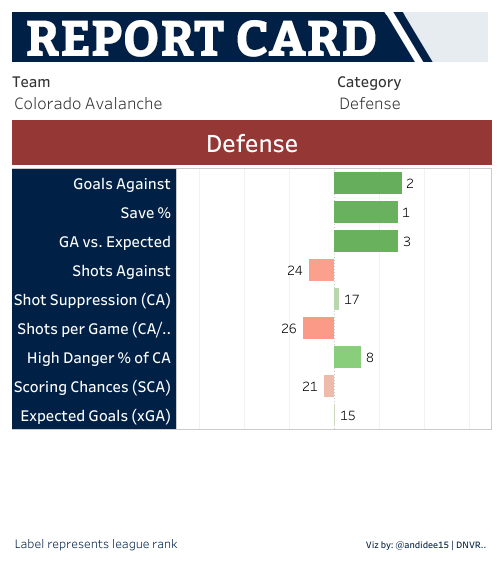
Remember how we said the Avs play less even strength time than anyone else in the league? On offense, that makes the numbers better because they have less of a chance to generate shots. On defense, the opposite is true. Any bad raw stat becomes much worse when filtered through that lens.
The Avs allow a lot of shots. There’s no getting around that. The “shot suppression” stat above looks fine until you factor in their 5v5 time on ice, and then… ooof.
Luckily, most of those shots are low danger. The Avs are perfectly content to let teams fire away from the point. They still do allow quite a few scoring chances, but proportionally, they do a good job mitigating quality. That’s the biggest reason why their expected goals number clocks in at average.
Even though the defense leaves a lot to be desired, luckily the goalies have been there to bail them out. Philipp Grubauer, in particular, has been fantastic and sits ninth in goals saved above expected.
He and backup Pavel Francouz are sitting in the .915 range overall, which is great considering league average is .904. At even strength, Grubauer is rocking a .934, good for eighth in the league even after Saturday’s debacle in the first period. Even the games by third and fourth-string goalies Adam Werner and Antoine Bibeau haven’t drastically impacted the team’s overall save percentage of .913.
Goaltending has been a strength so far this season, but they’re going to hit a rough patch at some point. One area where the Avs defense could improve to help them out is limiting the number of rebounds they face.
In hockey stats, a rebound is considered any shot coming within three seconds of a previous shot. So far this year, Avs goalies have faced 77 rebound shots (not just shot attempts, but on-target shots) at 5v5. Once you factor in time on ice, they clock in at 4.6 rebounds per 60, which is the third-highest rate in the league.
Many rebound shots come from the high danger areas of the ice, and they don’t allow the goalie much time to react or position themselves for the next save. If the Avs defense can do a better job of getting to the puck first and limiting these second and third chances, it would go a long way in lightening the goalies’ load.
Power Play
Ah, the man advantage. The area where it looks like the Avs are really really good until you realize they get WAY more opportunities than everyone else. Through 20 games, they’ve had 84 power plays, which is 19 more than league average. They’re also at 150 minutes total, which is 8 minutes more than the nearest team and nearly 100 minutes more than the Islanders. Sorry, Long Island. No man advantage for you.
Everything looks awesome until you factor in this time discrepancy. Overall, the Avs power play process is quite average. They’re average in generating high danger chances. They’re a bit below average in choosing to shoot the puck. And they’re average in the number of power plays they convert into goals.
This team is stinkin’ GOOD at drawing calls, a trend that has continued from last year. Unfortunately, there’s a lot of room to improve at actually doing something with it.
Getting Rantanen and Landeskog back on the first power play unit will certainly help, but both units play a very uptight style that doesn’t match their 5v5 play at all. They’ll get caught holding the puck too long, forcing a royal road pass (from wing to wing) when there are multiple defenders standing in the way and actively expecting it, and not utilizing the player in front of the net for much of anything.
With the shooting talent on this team and the fluid, chaotic style they love at 5v5, the fact the power play is this rigid and mediocre is highly unfortunate. It’s also a problem that’s hiding behind the stellar raw numbers and is unlikely to be addressed or changed any time soon.
Even without the refinement the power play system needs, if the Avs players commit to making faster decisions – shooting faster, passing faster, pinching faster – the speed that usually drew the penalty in the first place should open up more room and better passing lanes. It’s not a perfect fix, but it should increase the number of power-play goals.
Penalty Kill
The Avs take a lot of penalties, clocking in at the eighth-most penalized club in the league. Part of this is offset by the fact they’re so good at drawing them and refs like to keep games fairly even, plus Nikita Zadorov is routinely sent to the box for simply being big.
For these reasons, this generation of Avs is probably always going to be a bit on the high side of calls against. Even so, through the first 20 games, there’s been too much hooking and holding and tripping and “not moving your feet” penalties. Some of it is out of their control, but there’s still plenty of room to reasonably clean it up.
And they need to clean it up. The penalty kill has not been good. Just like at 5v5, they do a decent job limiting quality, but they’re getting crushed by quantity. Teams are firing a ton of shots at them, and they’re firmly entrenched in the bottom half of the league in the percent of PKs they kill.
Part of that has to do with the goaltending. As lights-out as Grubauer has been at 5v5, he’s hovered around league average on the PK. His .877 is only slightly above the .870 average. Francouz, Werner, and Bibeau all clock in at .800 and worse in smaller sample sizes.
It’s a window into what is likely to happen even at 5v5 if the Avs’ goalie luck runs out and their defensive process stays the same. Limiting quality alone isn’t enough.
While perhaps altering personnel could help – Sam Girard would be an interesting option on the PK, and if Cole and Zadorov clean up some of their penalties, they’d take some time away from Graves and Johnson and their very bad Corsi against rates. However, since the problems of the PK mirror the defensive problems at even strength, cleaning up the team-wide approach to defense is probably going to have a bigger impact on the penalty kill than anything else.
Conclusion
As we head into the second quarter of the year, the Avs have a lot of room where they can and should improve. Luckily, they aren’t doing anything particularly poorly (apart from staying healthy), but they aren’t doing anything particularly well process-wise either.
So far, they’ve found ways to win. The stats in no way cheapen that – standings points are standings points, and no one is going to take them because your Corsi wasn’t good that game. However, there are some… if not red flags, certainly pink flags to keep an eye on for the next 20 contests.
Over a long enough time period, results follow process. History has proved this over and over again. The Avs have been an average process team so far, but when healthy, they have the ability to be so much more. Some small changes or points of emphasis could really help optimize how they’re playing, and once they hit a cold streak, they’ll have the incentive to concentrate on them.
Comments
Share your thoughts
Join the conversation



